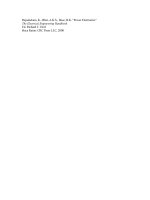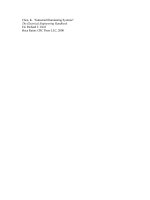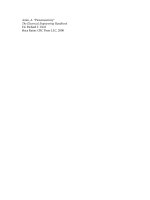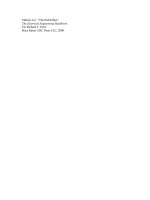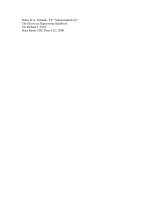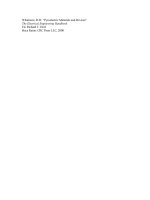Lecture Electrical Engineering: Lecture 18 - Dr. Nasim Zafar
Bạn đang xem bản rút gọn của tài liệu. Xem và tải ngay bản đầy đủ của tài liệu tại đây (762.4 KB, 38 trang )
COMSATS Institute of Information Technology
Virtual campus
Islamabad
Dr. Nasim Zafar
Electronics 1: EEE 231
Fall Semester – 2012
Transistor Biasing Circuits and Thermal
Stability.
Lecture No:
18
Nasim Zafar
2
References:
Ø Microelectronic Circuits:
Adel S. Sedra and Kenneth C. Smith.
Ø
Electronic Devices :
Thomas L. Floyd ( Prentice Hall ).
Ø
Integrated Electronics
Jacob Millman and Christos Halkias (McGrawHill).
Ø
Electronic Devices and Circuit Theory:
Robert Boylestad & Louis Nashelsky ( Prentice Hall ).
Ø
Introductory Electronic Devices and Circuits:
Nasim Zafar
Robert T. Paynter.
3
References for this Lecture:
Chapter No. 9
Ø Microelectronic Circuits:
Adel S. Sedra and Kenneth C. Smith.
Ø
Integrated Electronics :
Jacob Millman and Christos Halkias (McGrawHill).
Nasim Zafar
4
Objectives:
Ø
Ø
Ø
Ø
Discuss the concept of dc biasing of a transistor for the linear
operation in the active region.
Establish an operating point Q in this active region to provide
appropriate potentials and currents.
Analyze the voltagedivider bias, base bias, and collector
feedback bias circuits.
Establish a criterion for comparing the stability of different
biasing circuits.
Nasim Zafar
5
Transistor Biasing Circuits:
an Introduction
Ø
Ø
Biasing refers to the establishment of suitable dc values of different currents
and voltages of a given transistor.
Through proper biasing, a desired DC operating point or quiescent point;
QPoint of the transistor amplifier, in the active region (linear region) of the
characteristics is obtained.
Ø
The goal of amplification, in most cases, is to increase the amplitude of an ac
Nasim Zafar
6
signal without distortion or clipping the wave form.
Transistor Biasing Circuits:
an Introduction
Ø
The selection of a proper DC operating point or quiescent point, generally
depends on the following factors:
(a) The amplitude of the ac signal to be handled by the amplifier and
distortion level in signal. Applying large ac voltages to the base would result
in driving the collector current into saturation or cutoff regions resulting in a
distorted or clipped wave form.
(b) The load to which the amplifier is to work for a corresponding supply
voltage.
Nasim Zafar
7
The DC Operating Point:
Biasing and Stability
Ø
The goal of amplification, in most cases, is to increase the amplitude
of an ac signal without distortion or clipping the wave form.
Nasim Zafar
8
Transistor Output Characteristics:
IC
IB = 40µA
IC
IB = 30µA
IB = 20µA
IB = 10µA
Early voltage
Ø
Nasim Zafar
Cutoff
region
At a fixed IB, IC is not dependent on VCE
9
VCE
Transistor Output Characteristics:
Load Line – Biasing and Stability
The requirement is to set the Qpoint such that that it does not go into the
saturation or cutoff regions when an a ac signal is applied.
Nasim Zafar
10
The DC Operating Point:
Biasing and Stability
Slope of the Load Line:
VCC = VCE + VRC
VCE = VCC VRC
VCE = VCC IC
RC
Ic
1
( )VCE
Rc
VCC
RC
Nasim Zafar
11
The DC Operating Point:
Biasing and Stability
Ø
Ø
Load Line drawn on output characteristic curves.
–
Determines quiescent point, Q
–
Q is between saturation and cutoff
Best Q for a linear amplifier:
–
Midway between saturation and cutoff.
Nasim Zafar
12
The DC Operating Point:
Biasing and Stability
For this particular transistor we see that 30 mA of collector current is best for
maximum amplification, giving equal amount above and below the Qpoint.
Nasim Zafar
13
The DC Operating Point:
Biasing and Stability
QPoint and Current Gain β dc
Ø
β dc not a constant
Ø
β dc Dependent on:
Ø
–
Operating Point Q
–
Temperature
Active region limited by
–
Nasim Zafar
Maximum forward current, IC(MAX)
14
The DC Operating Point:
Biasing and Stability
The DC operating point of a transistor amplifier shifts
mainly due to changes in the temperature, since the
transistor parameters:
— β, ICO and VBE —are functions of temperature.
Ø
Ø
Ø
100 < β dc < 300
We will discuss some of the methods used for biasing the
transistor circuits.
Nasim Zafar
15
Transistor Biasing Circuits.
Nasim Zafar
16
Transistor Biasing Circuits:
Biasing Circuit Configurations:
Ø 1. FixedBiased Transistor Circuits.
Ø 2. FixedBiased with Emitter Resistance Circuits.
Ø 3. VoltageDividerBiased Transistor Circuits.
Nasim Zafar
17
Transistor Biasing Circuits:
Ø
Ø
1. FixedBiased Transistor Circuits.
Highly dependent on βdc
2. FixedBias with Emitter Resistance Circuits.
–
Add emitter resistor
–
Greatly reduces effects of change of β
–
Equations
–
highly dependent on
dc
NasimβZafar
18
1. FixedBiased Transistor Circuits.
Single Power Supply
Nasim Zafar
19
DC Voltages and Currents in a BJT:
v
Active region Amplifier: BJT acts as a signal amplifier.
1. BE Junction Forward Biased
C
C
IC
VBE ≈ 0.7 V for Si
2. BC Junction Reverse Biased
IC
B
B
IB
IB
E
IE
E
3. KCL: IE = IC + IB
Nasim Zafar
IE
20
1. FixedBiased Transistor Circuits:
–
Single Power Supply
21
Nasim Zafar
1. Transistor FixedBias Circuits:
Base–Emitter Loop:
Collector–Emitter Loop:
VCE = VCC IC RL
(a) FixedBias Circuit.
(b) Equivalent Circuit.
Nasim Zafar
22
1. Transistor FixedBias Circuits:
v
CurrentVoltage Equations for FixedBias circuits:
VCC − VBE
IB =
RB
IC = β I B
VCE = VCC − I C RC
23
Nasim Zafar
2. FixedBias with Emitter Resistance
Single Power Supply
Nasim Zafar
24
2. FixedBias with Emitter Resistance:
Ø
1. BaseEmitter Loop:
KCL: IE = IC + IB
The emitter current can be written as:
From the above two equation we get:
FixedBias Circuit with Emitter Resistance
Nasim Zafar
25
